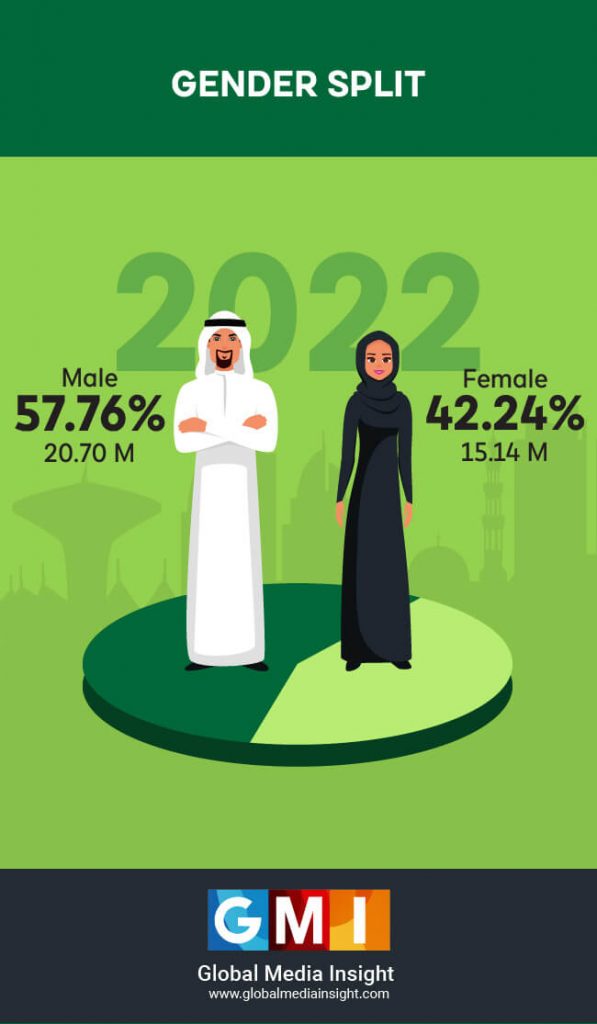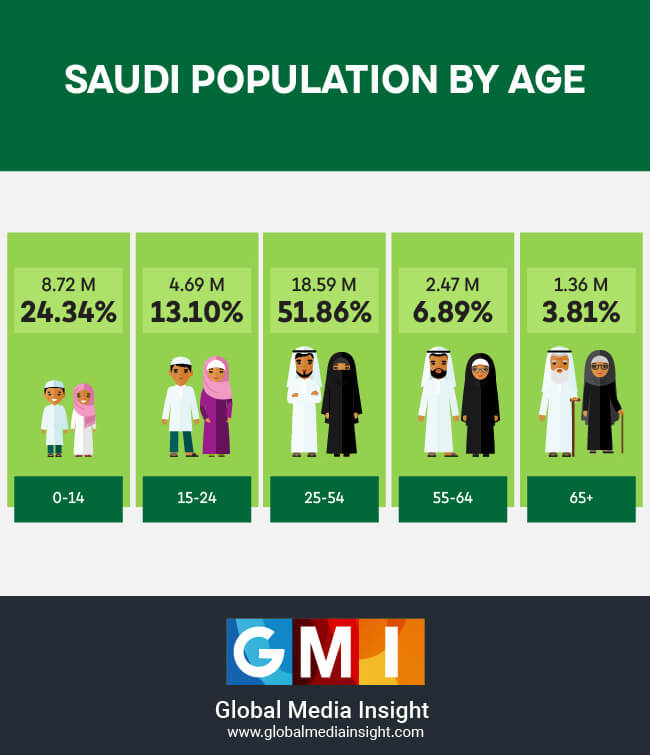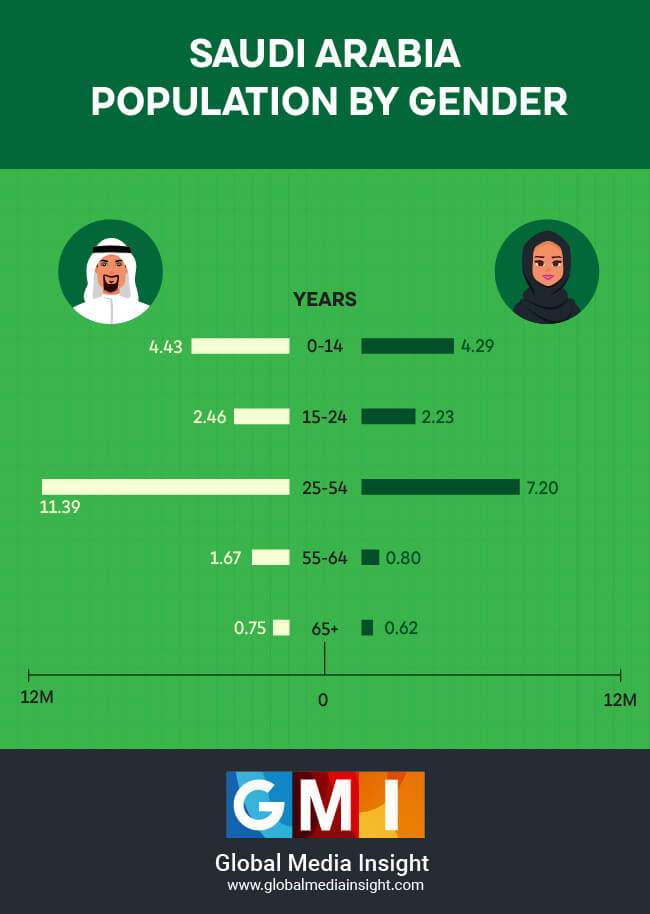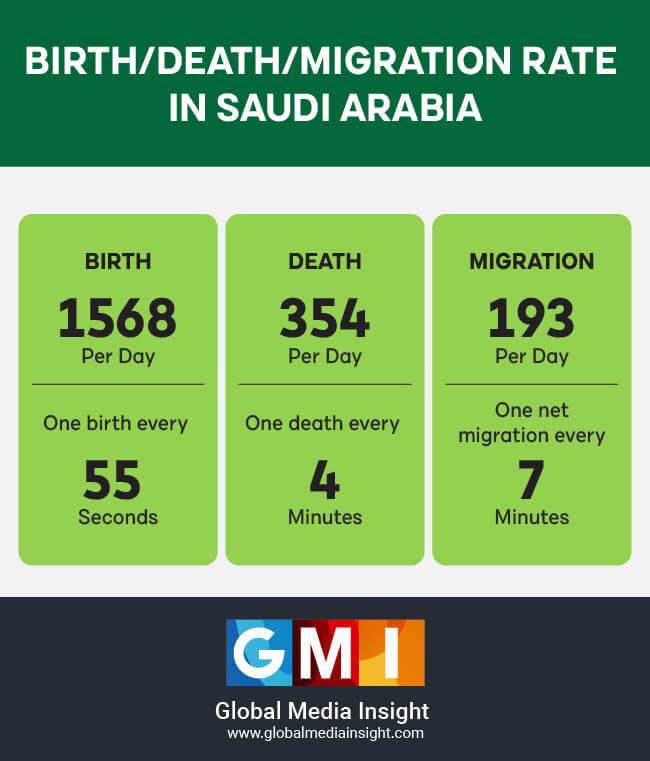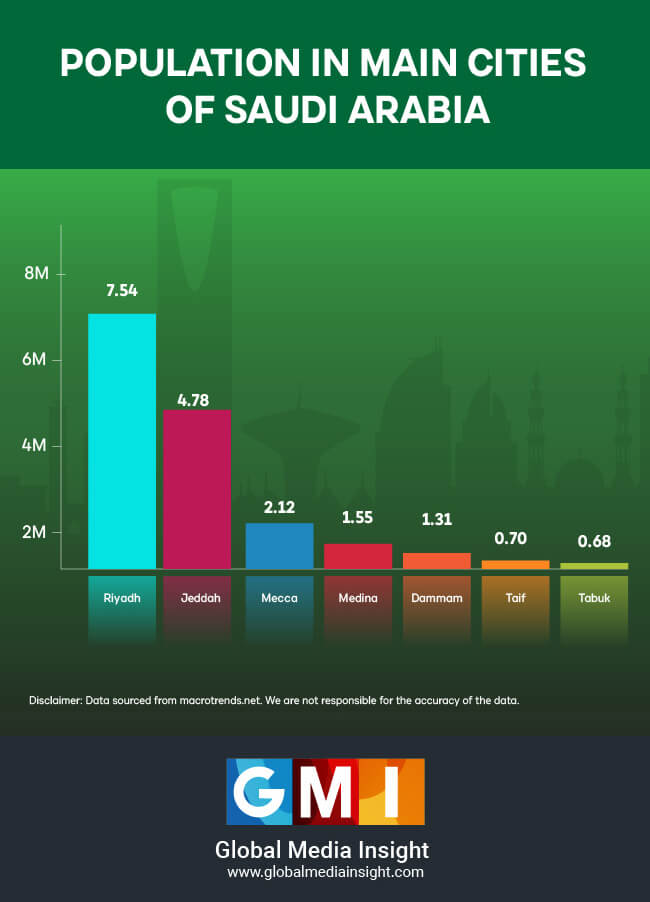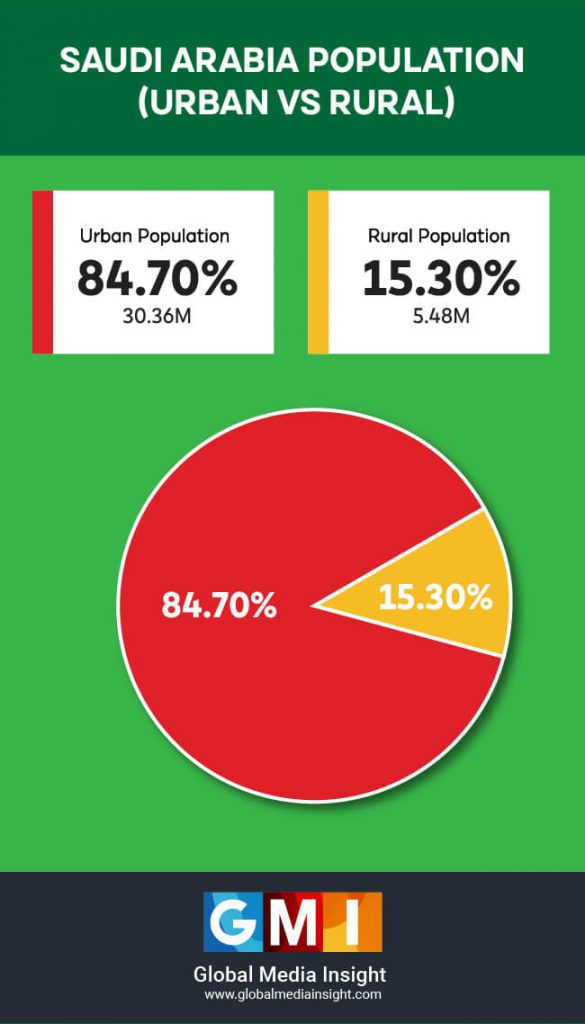SAUDI ARABIA LIVE Population Count
38,938,386
Saudi Arabia is the largest country in the Middle East.
Home to an estimated 0.46% of the global population, it is the 41st most populous country in the world.
But what constitutes its population?
Are expatriates in the majority or natives?
Do males have a higher representation or females?
Let’s find out.
Here, in this blog, we will examine the population statistics of Saudi Arabia as of 2024.
Saudi Population 2024 – Key Statistics
According to research conducted by the GMI team, the population of Saudi Arabia is 37.47 Million as of November 2024.
The population density of Saudi Arabia in 2024 is 17.43 people per square kilometer.
According to Embassy of India, the Indian population in Saudi Arabia is approximately 2.40 Million.
The male population in Saudi Arabia 2024 is 21.51 Million
The female population in Saudi Arabia 2024 is 15.96 Million
The urban population in Saudi Arabia 2024 is 31.77 Million
The median age in 2024 is approximately 30.6 years.
Riyadh is the most populated city in Saudi Arabia with 7.82 million people
Islam is the most practised religion in Saudi Arabia with 34.85 million followers
Saudi Population – An Overview
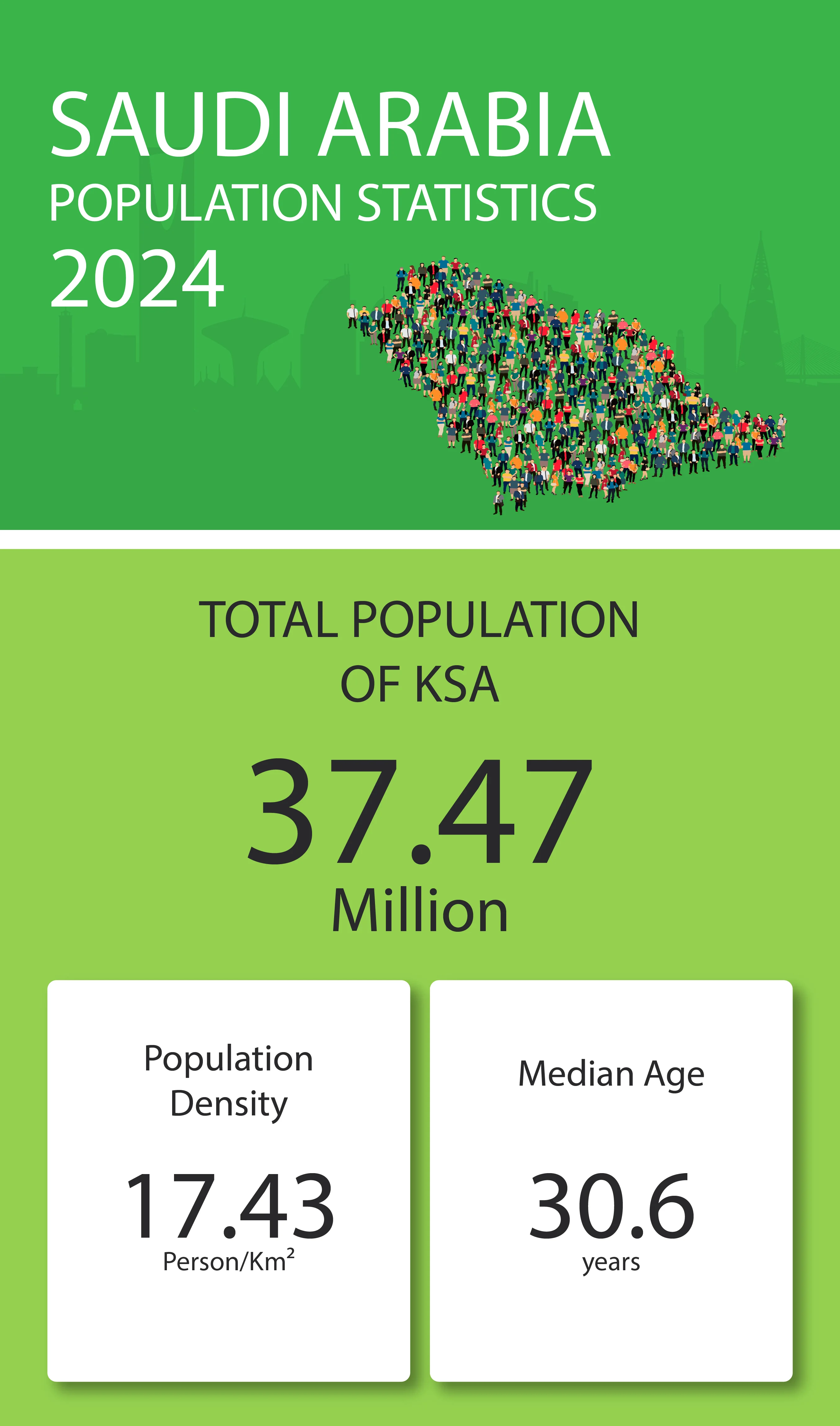
The Saudi Arabian population has grown significantly in recent years.
According to the 2022 census, the population was 32.12 million.
As of November 2024, the population of Saudi Arabia has increased to 37.47 million.
The population density in 2024 is 17.43 people per square kilometer, and the median age is approximately 30.6 years.
Saudi Arabia – Country in a nutshell

Saudi Arabia (Kingdom of Saudi Arabia) is a country with deep historical roots.
Revered by Muslims worldwide, KSA is home to the famous mosques Mecca and Medina, two of the most visited pilgrimage centers on earth.
KSA is divided into 13 provinces.
Each province has a governor, a deputy governor, and a provincial council.
These provinces are further subdivided into 118 governorates.
Until the middle of the 20th century, Saudi Arabia followed a traditional lifestyle.
With the rise of the Saud family (Al Sa Ud), the country began to witness transformations on all fronts.
Innovations in the field of transportation and technology fuelled more international relations.
With the massive financial growth brought about by petroleum resources, the country is now the 18th richest GDP in the world.
Today, in line with its “Vision 2030”, the country is actively working towards diversifying its oil-based economy and providing its people with more and varied economic and cultural opportunities.
This has led to a large influx of expats from all over the world, significantly changing the demographics of the region.
Saudi Arabia Population Statistics 2024 (Infographics)

Demographics of Saudi Arabia in 2024
Saudi Arabia, the fourth-largest state in the Arab world, has experienced significant population growth over the past 40 years.
This surge is attributed to improved living conditions and expanding economic opportunities.
Notably, most Saudis prefer settling in major cities like Riyadh and Jeddah, drawn by the charm of career prospects and a vibrant urban lifestyle.
Let us explore the demographics of Saudi Arabia in a more detailed manner.
Gender Split
Gender | Population | Population (%) |
Male | 21.51 Million | 57.39% |
Female | 15.96 Million | 42.61% |
According to our research, the population distribution in Saudi Arabia in 2024 indicates 21.51 million males, constituting 57.39%, and 15.96 million females, representing 42.61%.
Although we see a significant gender disparity in the above statistics, Saudi Vision 2030 is a helpful initiative towards reducing this gap.
Aiming for 31.40% of women in the workforce by 2025, the goal was surpassed early, reaching 35.6% by the second quarter of 2022.
Saudi Arabia has also seen many firsts like appointing the first female ambassador and sending the first female astronaut to space.
These milestones signal a shift towards greater gender inclusivity and a brighter future for Saudi Arabia.
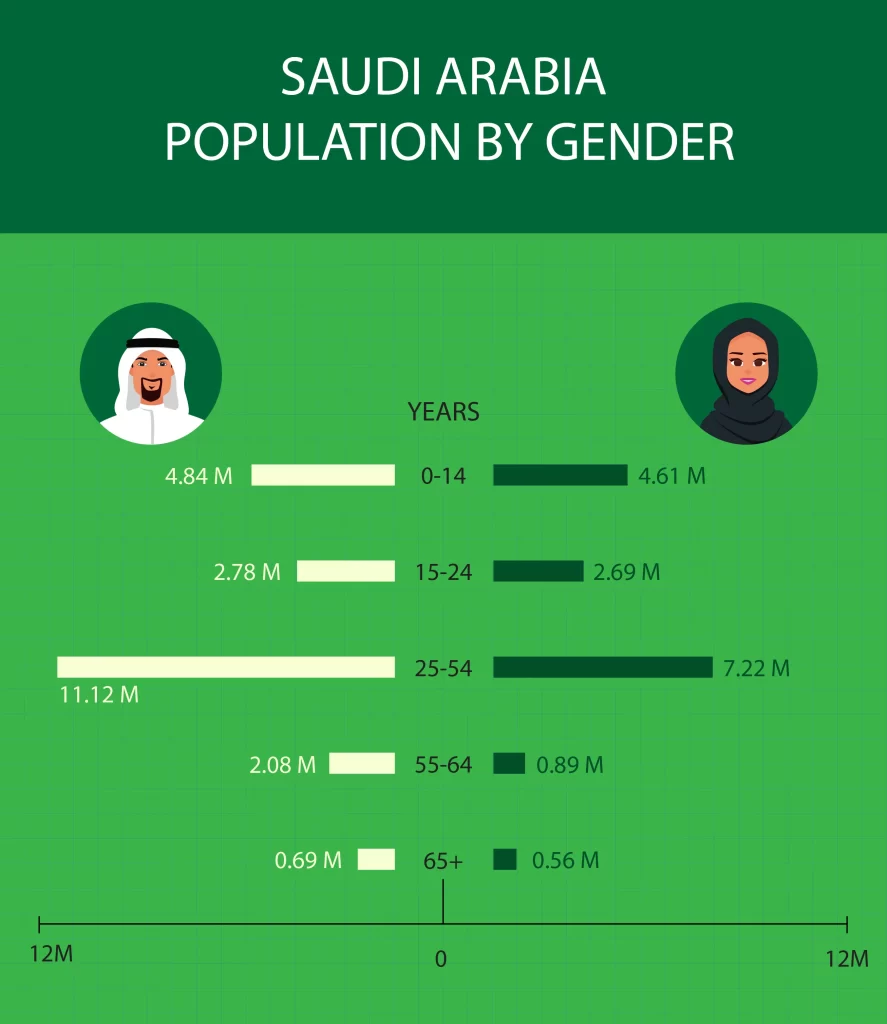
Saudi Population by Age
Age Group | Population | Population (%) |
0-14 years | 9.45 Million | 25.21% |
15-24 years | 5.47 Million | 14.61% |
25-54 years | 18.34 Million | 48.94% |
55-64 years | 2.97 Million | 7.92% |
65 years and above | 1.25 Million | 3.32% |
In Saudi Arabia’s 2024 population statistics, the demographic distribution across age groups reveals interesting patterns.
The 0-14 age bracket represents 25.21% of the population or 9.45 million people.
This suggests a sizable younger population, which can influence educational and familial dynamics.
The 25-54 age range holds the majority, constituting 48.94%, or 18.34 million.
This age group typically represents the working-age population, impacting economic productivity and societal development.
In contrast, the 65 years and over category comprises 3.32% of the total population or 1.2 million.
This category has a relatively smaller elderly population, which may have implications for healthcare and social support systems.
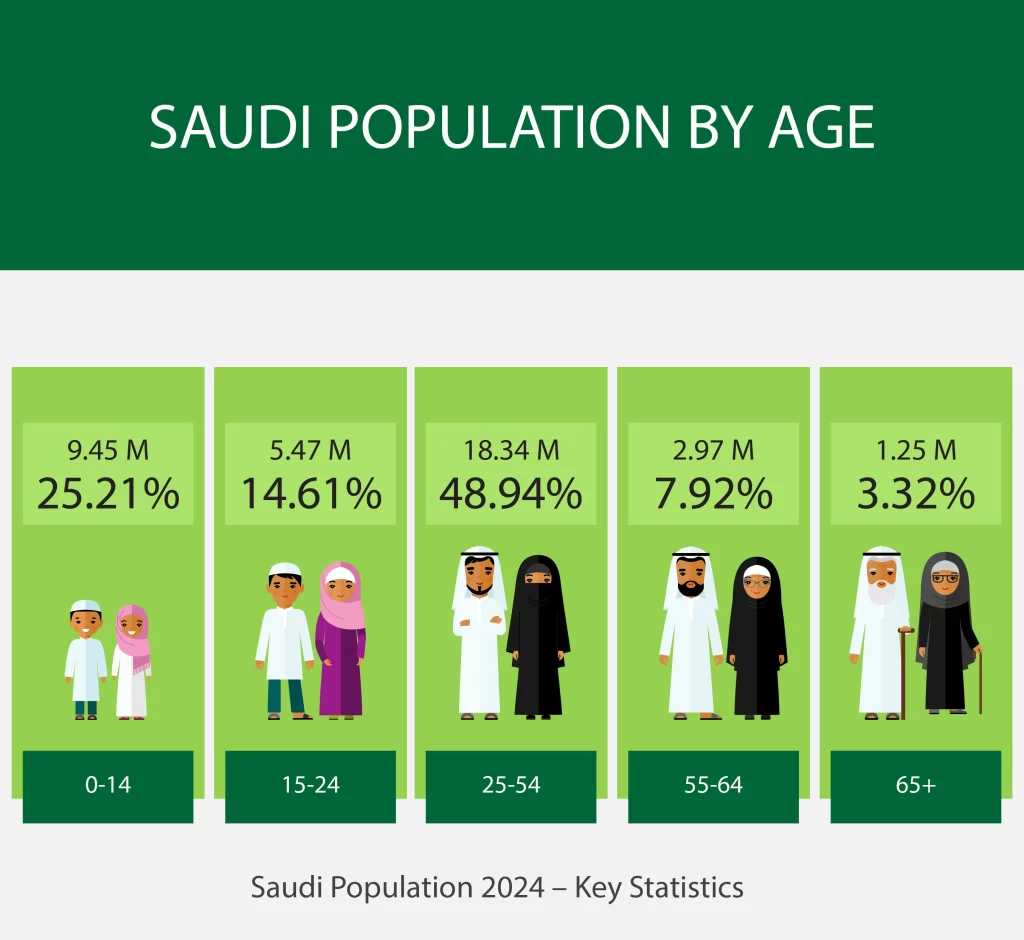
Saudi Population by Gender
Age Group | Men | Women |
0-14 years | 4.84 Million | 4.61 Million |
15-24 years | 2.78 Million | 2.69 Million |
25-54 years | 11.12 Million | 7.22 Million |
55-64 years | 2.08 Million | 0.89 Million |
65 years and above | 0.69 Million | 0.56 Million |
The population distribution by gender in Saudi Arabia for 2024 illustrates varying gender ratios across different age groups.
In the 0-14 age bracket, there are 4.84 million males and 4.61 million females, indicating a relatively balanced distribution among the younger demographic.
However, as we move to the 15-24 age range, a slight male predominance is observed, with 2.78 million males compared to 2.69 million females.
The most significant gender gap appears in the 25-54 age group, where 11.12 million men contrast with 7.22 million women, reflecting gender imbalances possibly influenced by economic and workforce dynamics.
In the 55-64 and 65 years and over categories, the male population consistently exceeds the female population.
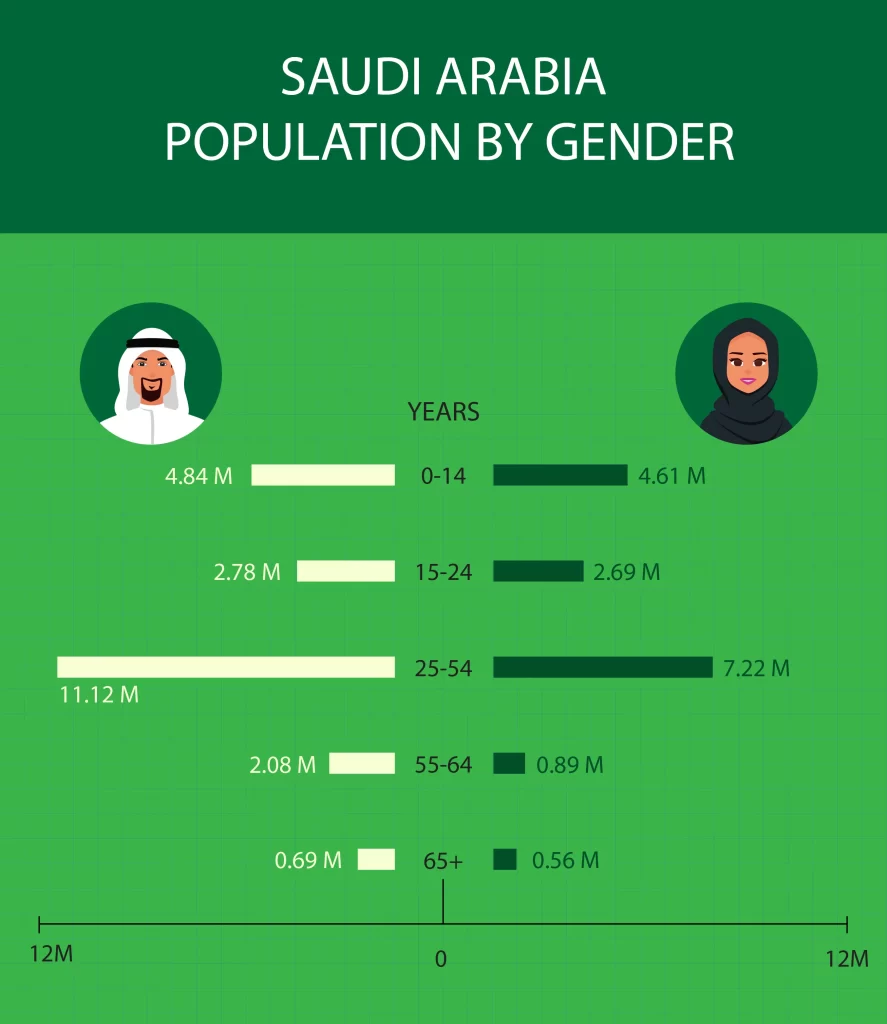
Saudi Population by Year (2010 – 2024)
| Year |
Population |
2024 | 37.47 Million |
2023 | 36.95 Million |
| 2022 | 35.84 Million |
|
2021 |
35.34 Million |
|
2020 |
34.81 Million |
|
2019 |
34.26 Million |
|
2018 |
33.70 Million |
|
2017 |
33.10 Million |
|
2016 |
32.44 Million |
|
2015 |
31.72 Million |
|
2014 |
30.92 Million |
|
2013 |
30.05 Million |
|
2012 |
29.15 Million |
|
2011 |
28.27 Million |
|
2010 |
27.42 Million |
The population statistics for Saudi Arabia over the years depict a consistent trend of growth, reflecting the nation’s evolving demographic landscape.
In 2010, the population stood at 27.42 million, and over the subsequent years, there has been a steady increase.
By 2024, the population has reached 37.47 million, showcasing a significant growth of nearly 10 million people over the past 14 years.
This upward course can be attributed to various factors such as improved healthcare, economic opportunities, and a growing expatriate community.
The data suggests that Saudi Arabia has been experiencing sustained development and attracting a diverse population.
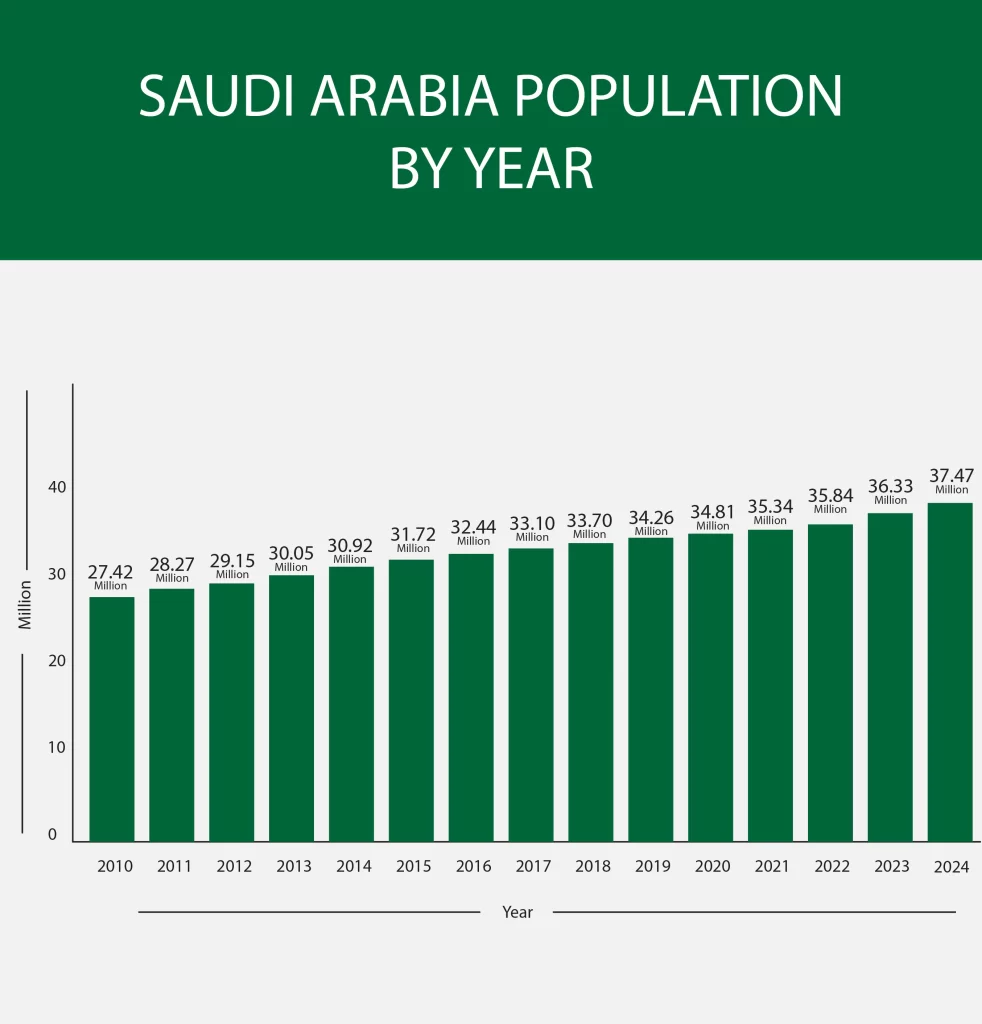
Saudi Arabia Birth Rate, Death Rate & Migration Rate 2024
Births | 1645/Day | 53 Seconds |
Deaths | 295/Day | 4.88 Minutes |
Migrations | 79/Day | 18.23 Minutes |
Saudi Arabia’s daily demographic dynamics showcase a substantial influx of life.
With 1645 births occurring daily, equivalent to a new birth every 53 seconds, the nation experiences a vibrant growth in its population.
This high birth rate may stem from factors like cultural norms, improved healthcare, and a relatively young population contributing to family expansion.
On the other side, the daily mortality rate stands at 295 deaths, translating to one passing every 4.88 minutes.
While this signifies a natural part of population dynamics, it also prompts considerations for healthcare infrastructure and end-of-life care resources.
The net migration rate of 79 individuals per day, or one person every 18.23 minutes, points to the country’s attractiveness for people seeking opportunities, emphasizing Saudi Arabia’s economic appeal and global integration.
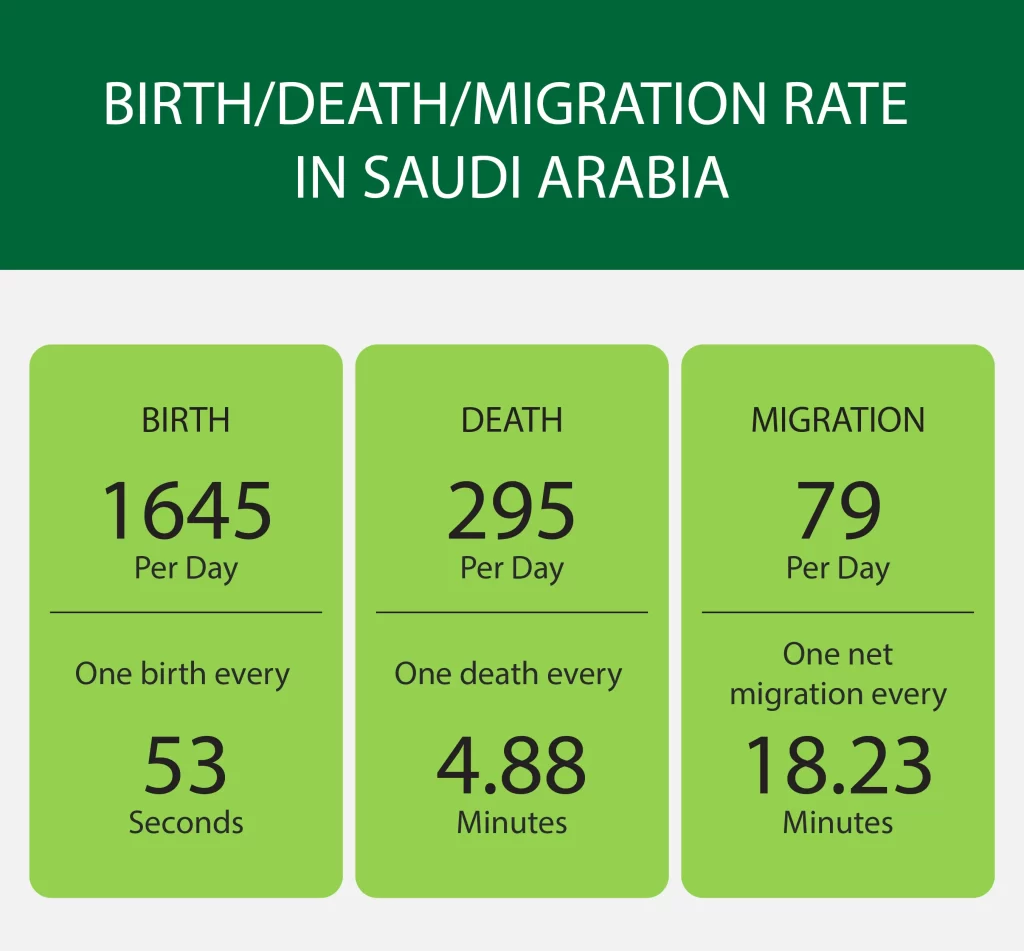
Population in Main Cities of Saudi Arabia 2024
|
City |
Population |
|
Riyadh | 7.82 Million |
|
Jeddah | 4.94 Million |
|
Mecca | 2.19 Million |
|
Medina | 1.60 Million |
|
Dammam | 1.35 Million |
|
Taif | 0.72 Million |
|
Tabuk | 0.70 Million |
Saudi Arabia’s urban landscape is characterized by population concentrations in its main cities.
Riyadh, the capital, leads with 7.82 million residents, emphasizing its status as the political and economic hub.
Jeddah follows closely with 4.94 million, known for its coastal charm and cosmopolitan atmosphere.
Mecca, a significant religious center, has 2.19 million inhabitants, while Medina, another important pilgrimage site, has 1.60 million.
Dammam, at 1.35 million, stands out as a key eastern city with economic significance.
Additionally, Taif and Tabuk contribute to the urban landscape with 0.72 million and 0.70 million residents, respectively.
This city-wise population distribution showcases the diverse urban centers in Saudi Arabia, each playing a unique role in the country’s economic, cultural, and religious landscape.
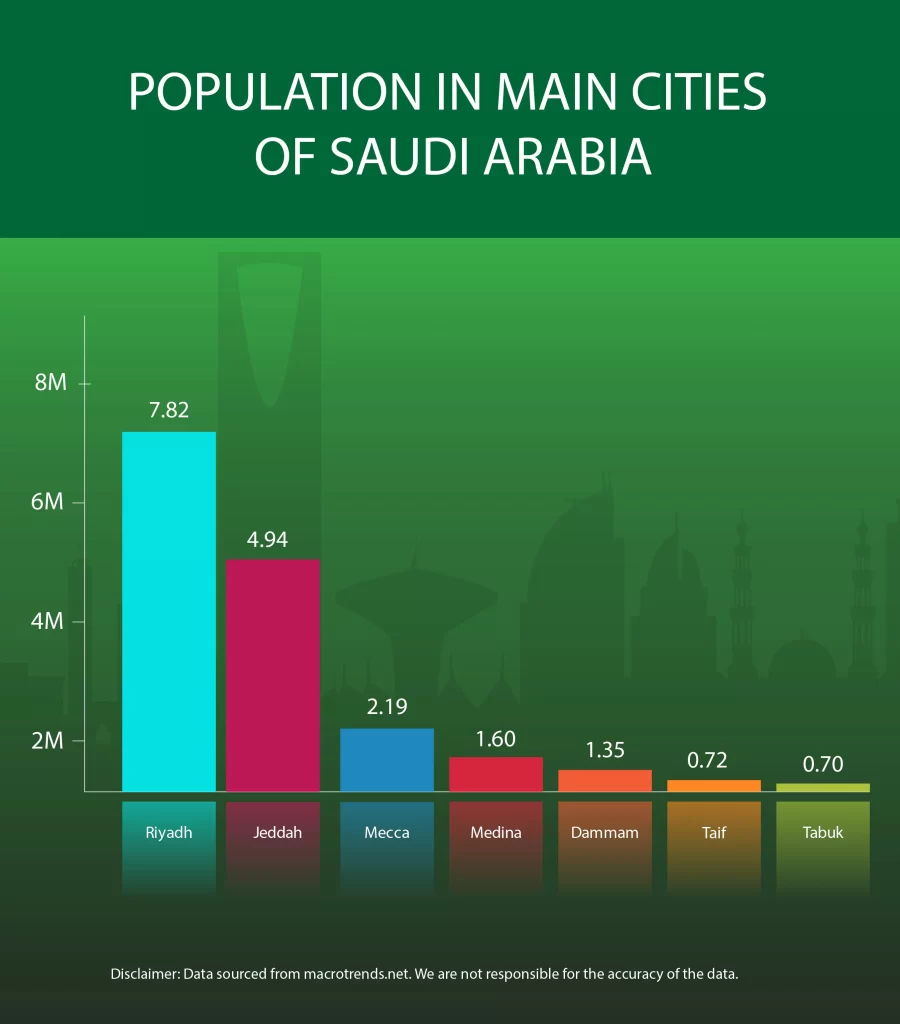
Saudi Arabia Population 2024 (Urban vs Rural)
Urban | 31.77 Million | 84.80% |
Rural | 5.70 Million | 15.20% |
The population distribution in Saudi Arabia reflects a predominantly urbanized landscape, with 84.8% of the population residing in urban areas, totalling 31.77 million people.
This high urban percentage signifies the country’s rapid urbanization and economic development, drawing people to cities for opportunities and modern amenities.
In contrast, the rural population constitutes 15.2%, amounting to 5.70 million individuals.
While the urban centers, including Riyadh, Jeddah, and Mecca, contribute significantly to the country’s vibrancy and economic growth, the rural areas maintain their unique cultural and traditional characteristics.
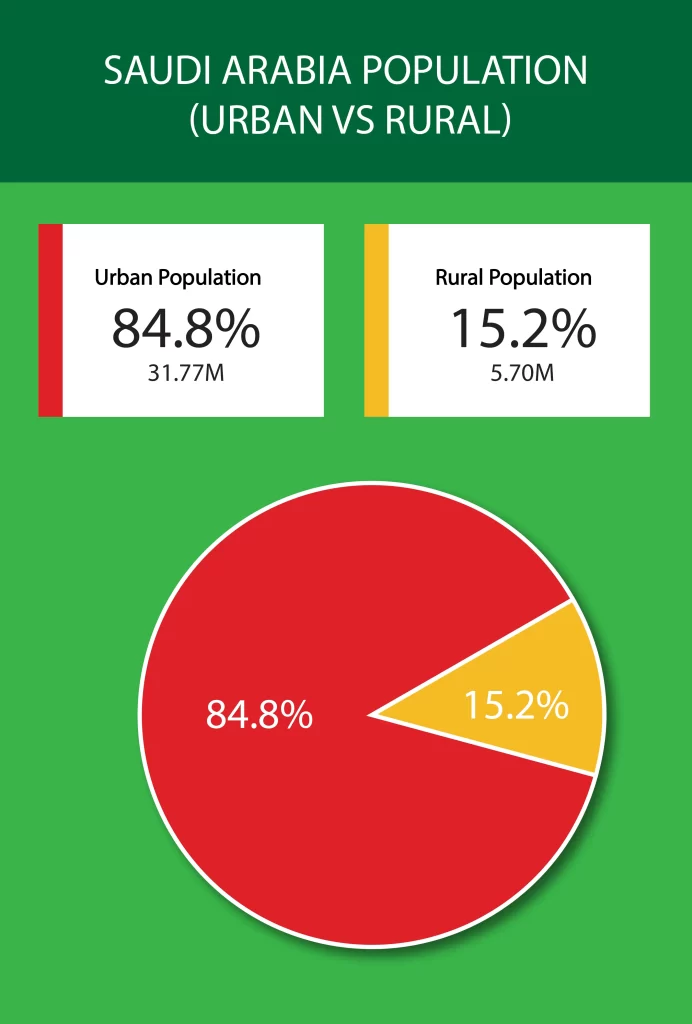
Saudi Arabia Population by Religion 2024
Religion | Percentage | Population (in Million) |
Islam | 93% | 34.85 M |
Christianity | 4.4% | 1.65 M |
Hinduism | 1.1% | 0.41 M |
Religiously Unaffiliated | 0.7% | 0.26 M |
Folk or traditional religions | 0.3% | 0.11 M |
Buddhism | 0.3% | 0.11 M |
Others | 0.2% | 0.07 M |
In Saudi Arabia’s religious landscape for 2024, Islam is the predominant faith, representing 93% of the population, equivalent to 34.85 million individuals.
Christianity follows at 4.4%, comprising 1.65 million people, showcasing a diverse religious composition within the country.
Hinduism and Religiously Unaffiliated categories hold 1.1% and 0.7%, totalling 0.41 million and 0.26 million, respectively.
Folk or traditional religions, along with Buddhism, each contribute 0.3%, amounting to 0.11 million individuals.
The ‘Others’ category represents 0.2%, encompassing 0.07 million people.
These religious demographics underline Saudi Arabia’s cultural and religious diversity.
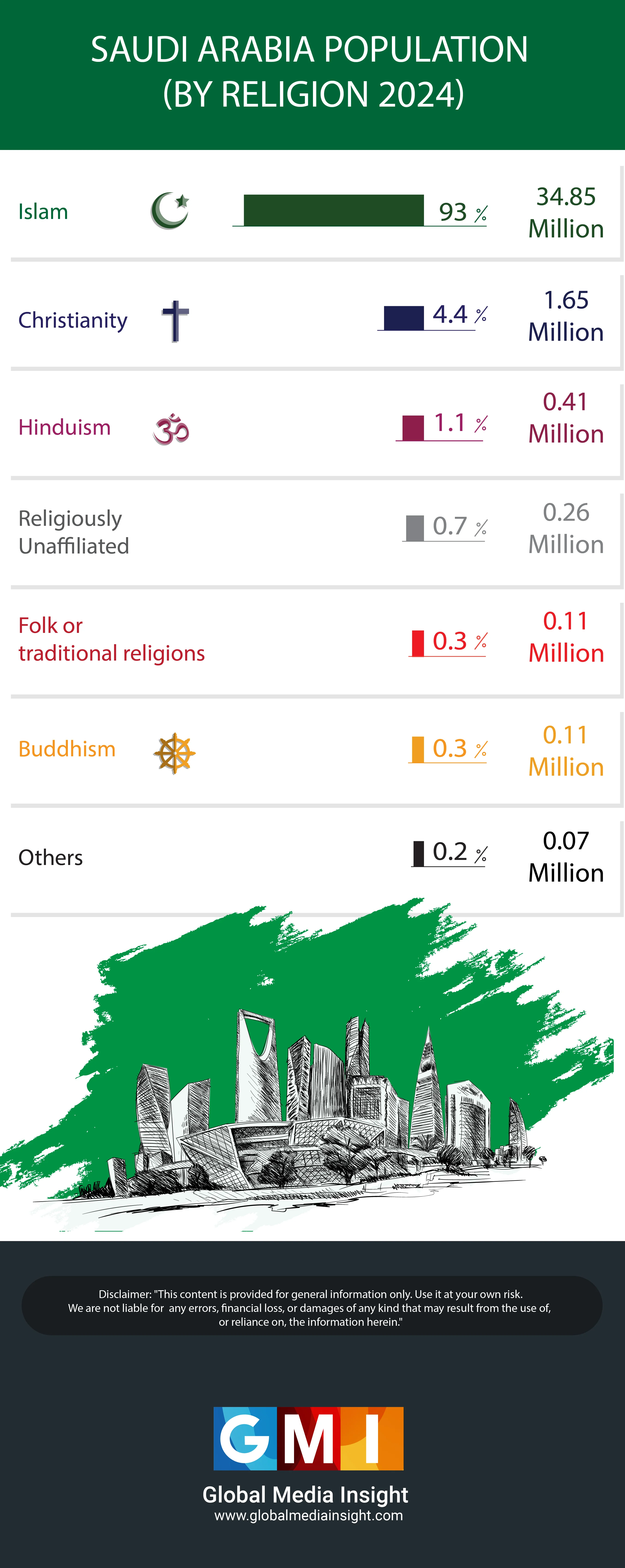
Now, let’s look at the KSA population statistics 2022 census data
Saudi Population Government Census – Key Statistics
According to the 2022 census, the total population of KSA is 32.12 million.
The median age is 29 years.
The fertility rate is 2.8.
The Saudi dependency ratio is 62.
Of the total population, 58.4% are Saudis, while 41.6% are non-Saudis.
Males make up 61.2% of the population, while females make up 38.8% of the population.
The average household size of Saudis is 4.8, while the average household size of non-Saudis is 2.7.
Indian population in Saudi Arabia 2023 is 1.88 Million according to 2022 Saudi census.
Now, let us examine the some of the important findings from the KSA 2022 Census in detail:
Saudi Population Government Census – Infographics

Gender Split
| Gender | Population | Percentage |
| Male | 19.70 Million | 61.20% |
| Female | 12.50 Million | 38.80% |
There is a clear gender disparity in the population, with males outnumbering females. There are 19.70 million males compared to 12.50 million females in Saudi Arabia.
However, Saudi Arabia is actively taking proactive steps to bridge this gap, including Vision 2030, which focuses on providing more socio-economic opportunities to women. Till now, the initiatives have resulted in the following opportunities for females: the right to drive and obtain passports, jobs in the military and armed forces, giving them the right to property, etc. These decisions reflect the nation’s commitment to creating a more inclusive society.
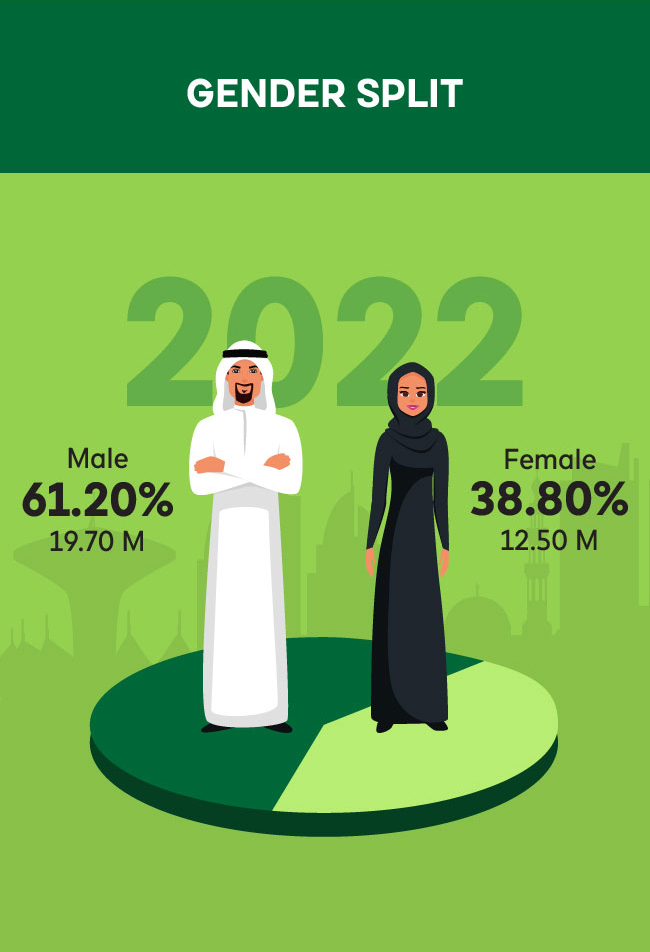
Nationality Split
| Nationality | Population | Percentage |
| Saudi | 18.80 Million | 58.40% |
| Non Saudi | 13.40 Million | 41.60% |
When it comes to the nationality split, Saudi nationals dominate the country with a total of 18.8 million, while non-Saudis account for only 13.4 million of the total population.
This can be attributed to the fact that Saudis have excellent opportunities within the country, thanks to Nitaqat or Saudization programmes. In addition, the Saudis also receive many economic incentives, including healthcare, housing, education, etc.
All of this significantly helps KSA retain its nationals, even though many sectors such as construction, healthcare, etc., rely on migrant workers.
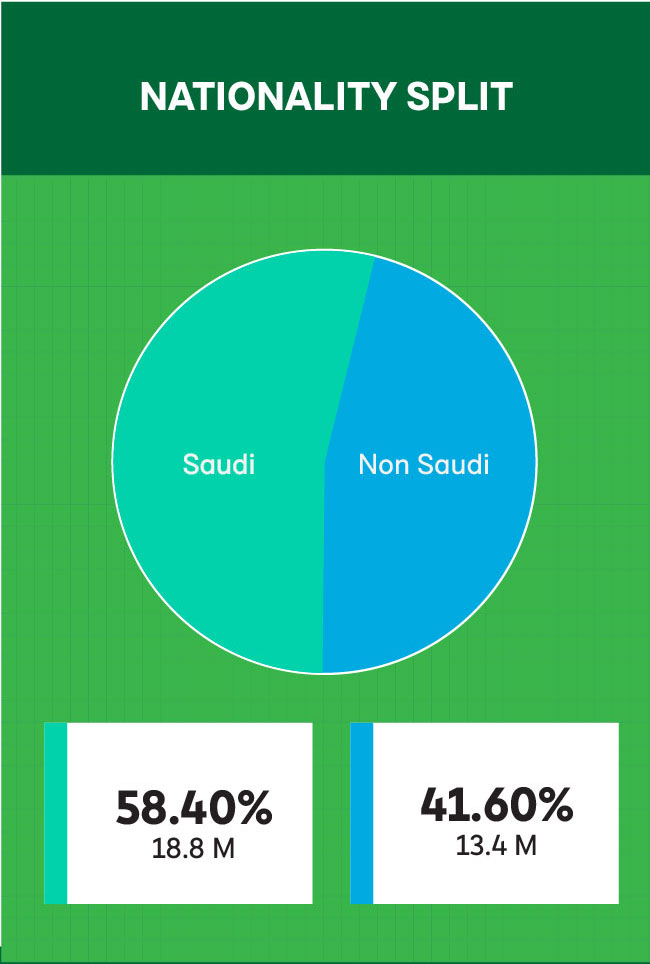
Saudi Population by Age
| Age Group | Population | Percentage |
| 0-14 Years | 7.89 Million | 24.51% |
| 15-19 Years | 2.20 Million | 6.83% |
| 20-24 Years | 2.62 Million | 8.13% |
| 25-54 Years | 16.97 Million | 52.75% |
| 55-64 Years | 1.64 Million | 5.11% |
| 65-69 Years | 0.37 Million | 1.15% |
| 70-74 Years | 0.21 Million | 0.64% |
| 75+ Years | 0.29 Million | 0.90% |
When we examine the age-wise demographics of the KSA population, the age group 25-54 years constitute the majority. They account for 16.97 million or 52.75% of the population. This is the prime working age population of KSA, or the driving force of the KSA economy.
On the other hand, the lowest percentage of people is found in the 70-74 age group, comprising 0.21 million people or 0.64% of the total population.
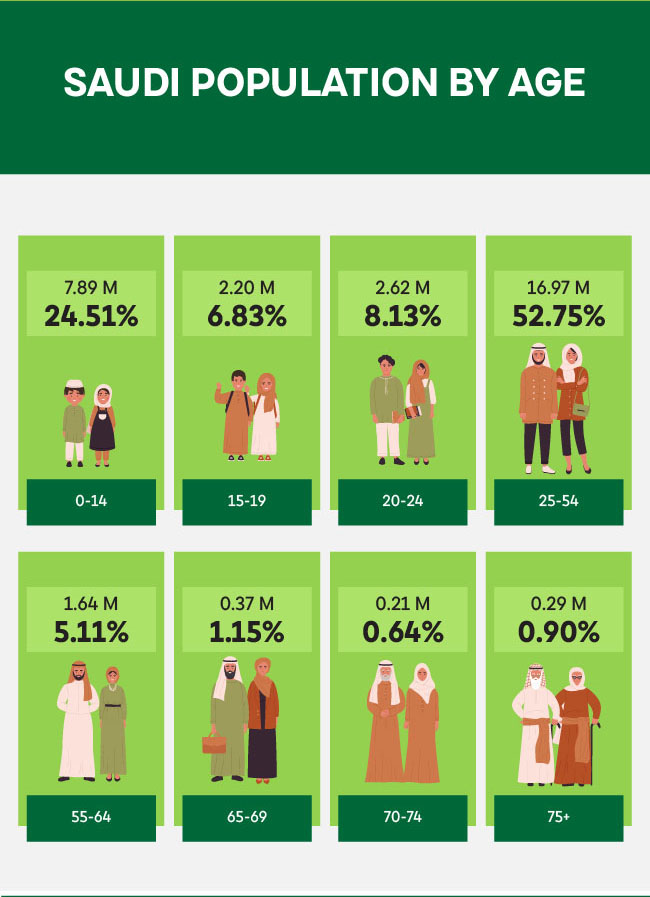
Saudi Population By Nationality
| Nationality | Population | Male | Female |
| Bangladesh | 2.12 Million | 1.95 Million | 0.17 Million |
| India | 1.88 Million | 1.71 Million | 0.17 Million |
| Pakistan | 1.81 Million | 1.65 Million | 0.16 Million |
| Yemen | 1.80 Million | 1.33 Million | 0.47 Million |
| Egypt | 1.47 Million | 1.18 Million | 0.29 Million |
| Sudan | 0.82 Million | 0.67 Million | 0.15 Million |
| Philippines | 0.73 Million | 0.27 Million | 0.46 Million |
| Syrian Arab Republic | 0.45 Million | 0.26 Million | 0.19 Million |
| Nepal | 0.30 Million | 0.29 Million | 0.01 Million |
| Jordan | 0.20 Million | 0.11 Million | 0.09 Million |
| Indonesia | 0.18 Million | 0.05 Million | 0.13 Million |
| Myanmar | 0.16 Million | 0.09 Million | 0.07 Million |
| Ethiopia | 0.16 Million | 0.04 Million | 0.12 Million |
| Afghanistan | 0.13 Million | 0.09 Million | 0.04 Million |
| Others | 1.17 Million | 0.53 Million | 0.64 Million |
According to the latest KSA census report released in May 2023, out of the total expat population of 41.6%, Bangladeshi nationals occupy the first position with 2.12 million people. Of these, 1.95 million are males and 0.17 million are females. The second position is occupied by Indians, with 1.88 million in which 1.71 million are males and 0.17 million are females. The third position is occupied by Pakistani nations with 1.81 million,where 1.65 million are males and 0.16 million are females.

Saudi Population 2023 – Key Statistics
As 2023 begins, here are some key statistics of the population of Saudi Arabia for this year.
The data was collected and compiled from several credible sources to get a better look at Saudi Arabia’s development over the past year.
According to research conducted by the GMI team, the population of Saudi Arabia is 36.33 Million
The population density of Saudi Arabia is 17.19 people per square kilometer.
The Median Age in 2023 is appoximately 30.5 years
Saudi Arabia accounts for 0.46% of the world’s total population.
Saudi Population Statistics 2023 [Infographics]

Demographics of Saudi Arabia in 2023
KSA is a Muslim-majority country with a native population of 90% Arabs and 10% Afro-Arabs. Although Islam is the official religion of the region, there are people of other faiths as well due to the presence of a large expatriate community.
37% of the Saudi population in 2023 is young, under the age of 25. Here is a more detailed breakdown of the country’s demographics.
Gender Split
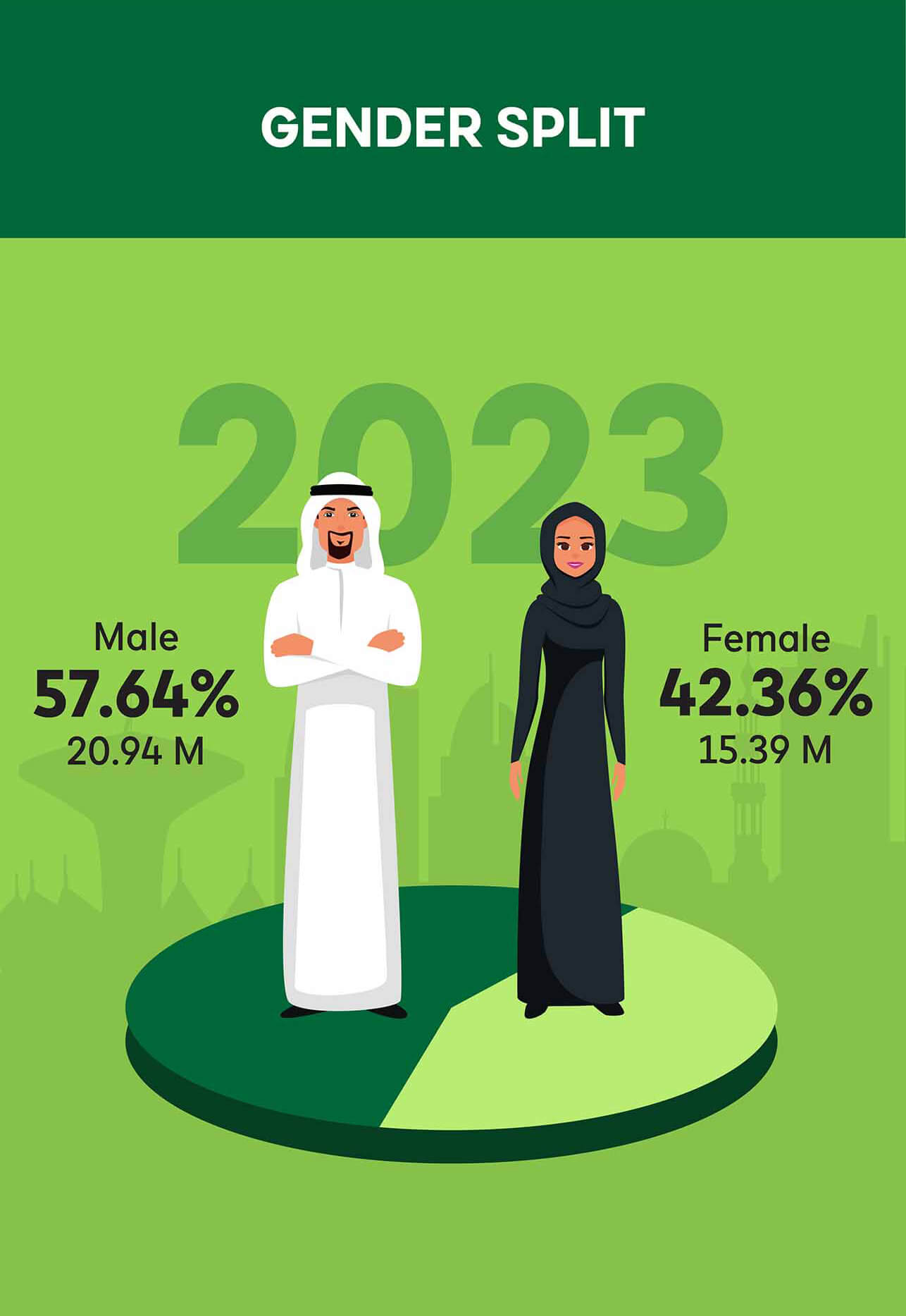
Saudi Arabia is the largest country in the Arabian Peninsula with a total population of 36.95 Million. Like many Arab countries, there is a predominance of the male population in the country, a part of it owing to the male expat workforce. The country has a low gender ratio with the male population at 20.94 Million i.e. 57.64%, and the female population at 15.39 Million i.e. 42.36%. The latest statistics reveal that there are 137.13 males per 100 females.
However, the country is making efforts to remove the gender disparity. According to the Gender Gap Index released in 2022 by the World Economic Forum, Saudi Arabia has gained a higher place – 127th among 146 countries, compared to previous years. Saudi Arabia has bridged 63.6% of its gender gap. Female participation in the workforce has also increased by 0.097% in 2022.
Gender | Population | Population (%) |
Male | 20.94 Million | 57.64% |
Female | 15.39 Million | 42.36% |
Saudi Population by Age
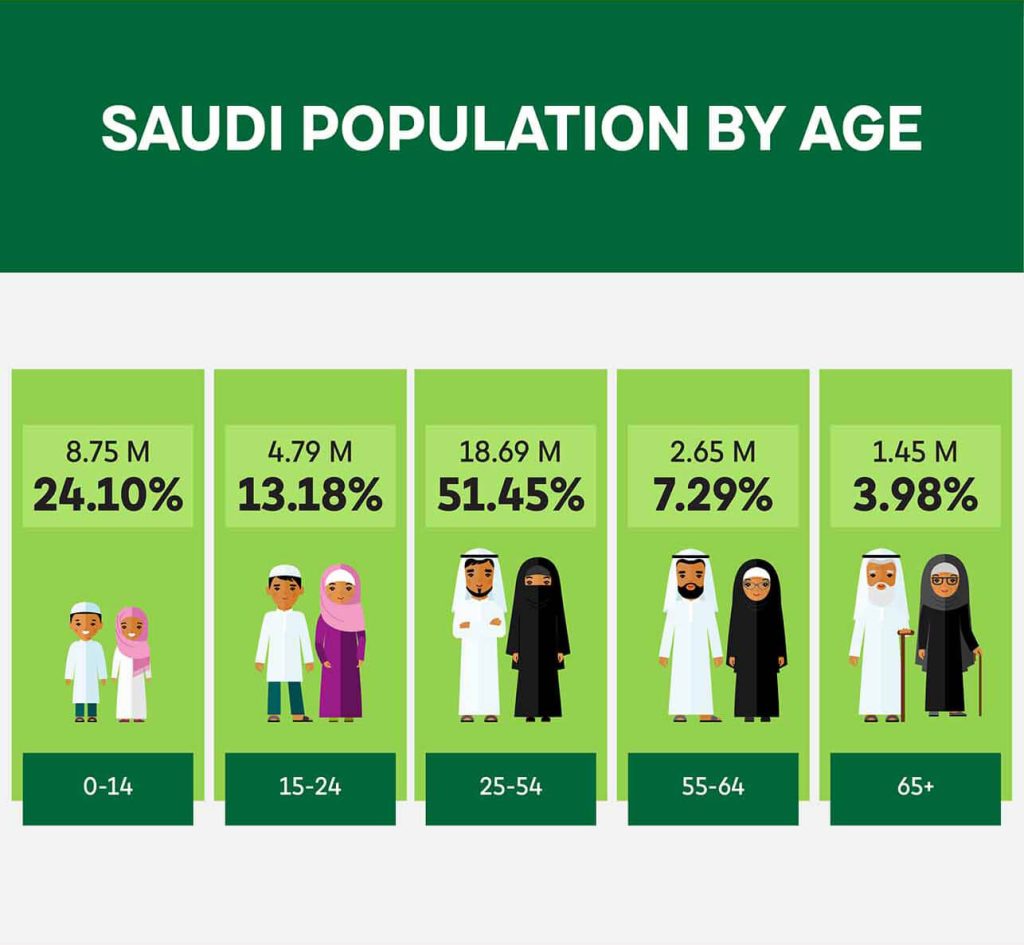
Individuals aged 25–54 constitute the majority of the population in 2023, accounting for 18.69 million, or 51.45% of the total population. This is indicative of the demands in the labor market and economic sector for expatriate workers, who form a large part of this age group. Quality of Life Program (part of Vision 2030) could be one factor that is attracting skilled expats to Saudi Arabia.
The lowest population percentage can be seen in the age group 65 years and older, which consists of only 1.45 million people in total. However, it has been observed that in recent years, elderly people have improved in health and the average lifespan has increased. With fluctuating birth and death rates in KSA, it is possible to see significant differences in these statistics in the future.
Age Group | Population | Population (%) |
0-14 years | 8.75 Million | 24.10% |
15-24 years | 4.79 Million | 13.18% |
25-54 years | 18.69 Million | 51.45% |
55-64 years | 2.65 Million | 7.29% |
65 years and above | 1.45 Million | 3.98% |
Saudi Population by Gender
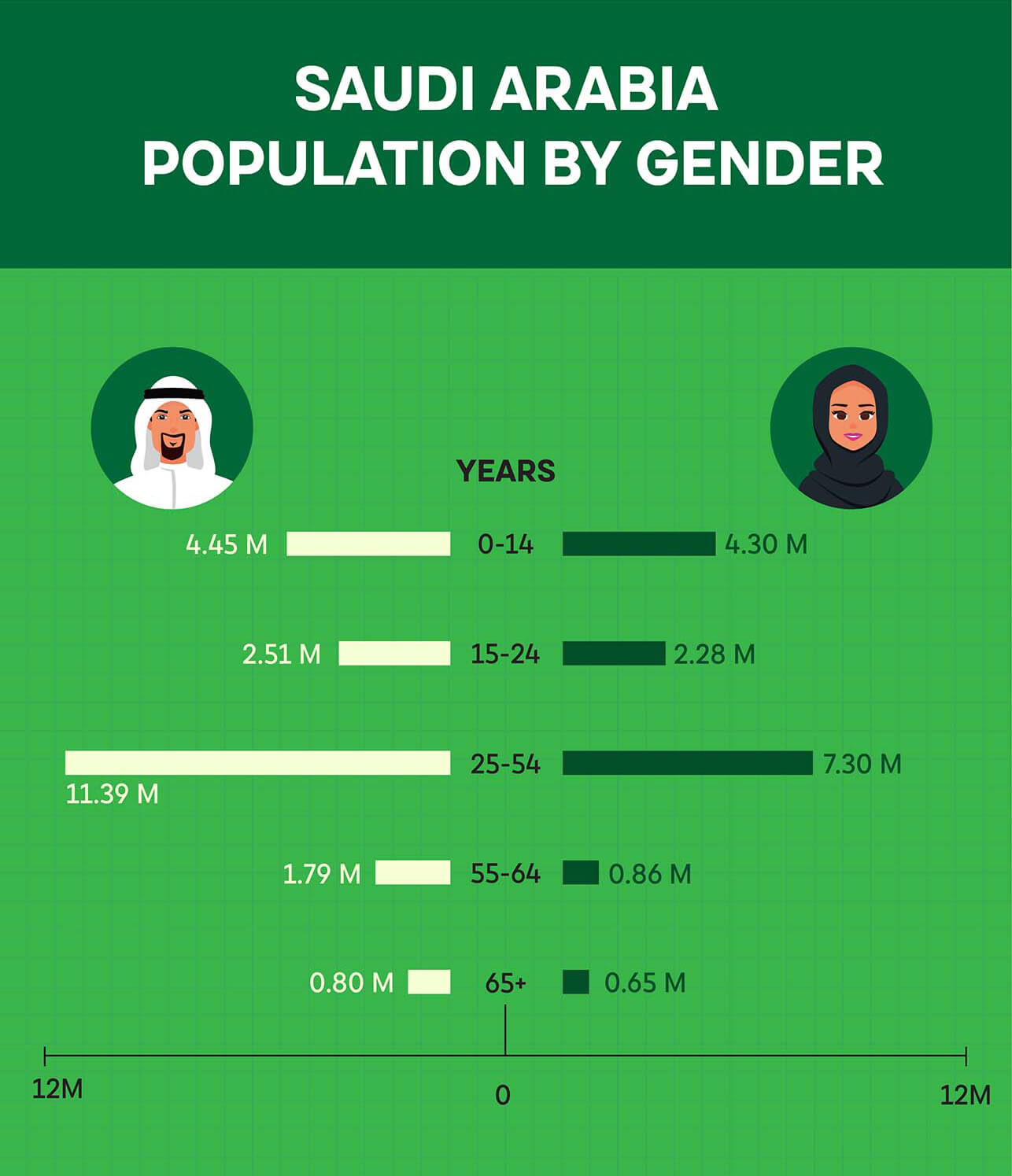
When we look at the gender distribution of the population, we can see that men predominate throughout all age groups. With 11.39 million men and 7.30 million women, the 25–54 age group has the highest population for both sexes among all age groups. This can be due to the fact the vast majority of working adults fall in this age group.
An interesting point to note here is the effort of the Saudi government (Vision 2030) to help women achieve an equal footing in society. At present, Saudi women comprise 33.6 % of the total workforce. Five years ago it was only 17.4%.
Age Group | Men | Women |
0-14 years | 4.45 Million | 4.30 Million |
15-24 years | 2.51 Million | 2.28 Million |
25-54 years | 11.39 Million | 7.30 Million |
55-64 years | 1.79 Million | 0.86 Million |
65 years and above | 0.80 Million | 0.65 Million |
Saudi Population by Year (2010 – 2023)
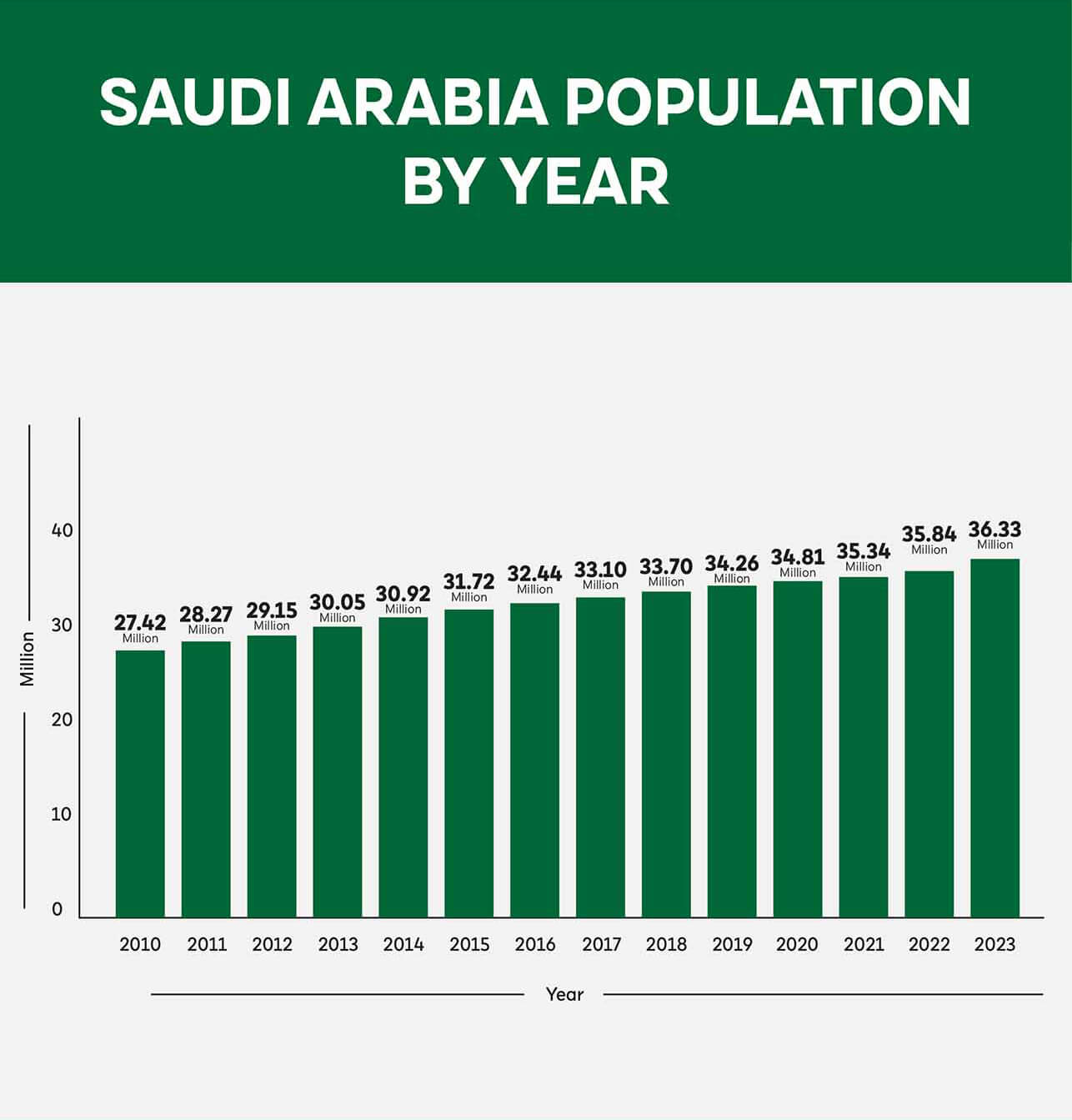
A fundamental change in Saudi Arabia’s population started as the oil resources were found in the 1930s. Following this socioeconomic changes caused rapid population growth. After that, the population growth rate fluctuated based on economic growth and opportunities for migration. By analyzing the chart we can see a consistent increase of 1 million people every year since 2010. From 27.42 million in 2010 to 36.95 million people in 2023, there has been an increase of around 9 million people over the last 13 years.
The country adopted numerous pronatalist programmes as the number of expatriates increased, which led to higher birth rates and lower mortality rates. The nation’s quick urbanization has also aided in the constant growth of the population.
| Year |
Population |
2023 | 36.95 Million |
| 2022 | 35.84 Million |
|
2021 |
35.34 Million |
|
2020 |
34.81 Million |
|
2019 |
34.26 Million |
|
2018 |
33.70 Million |
|
2017 |
33.10 Million |
|
2016 |
32.44 Million |
|
2015 |
31.72 Million |
|
2014 |
30.92 Million |
|
2013 |
30.05 Million |
|
2012 |
29.15 Million |
|
2011 |
28.27 Million |
|
2010 |
27.42 Million |
Population in Main Cities of Saudi Arabia 2023
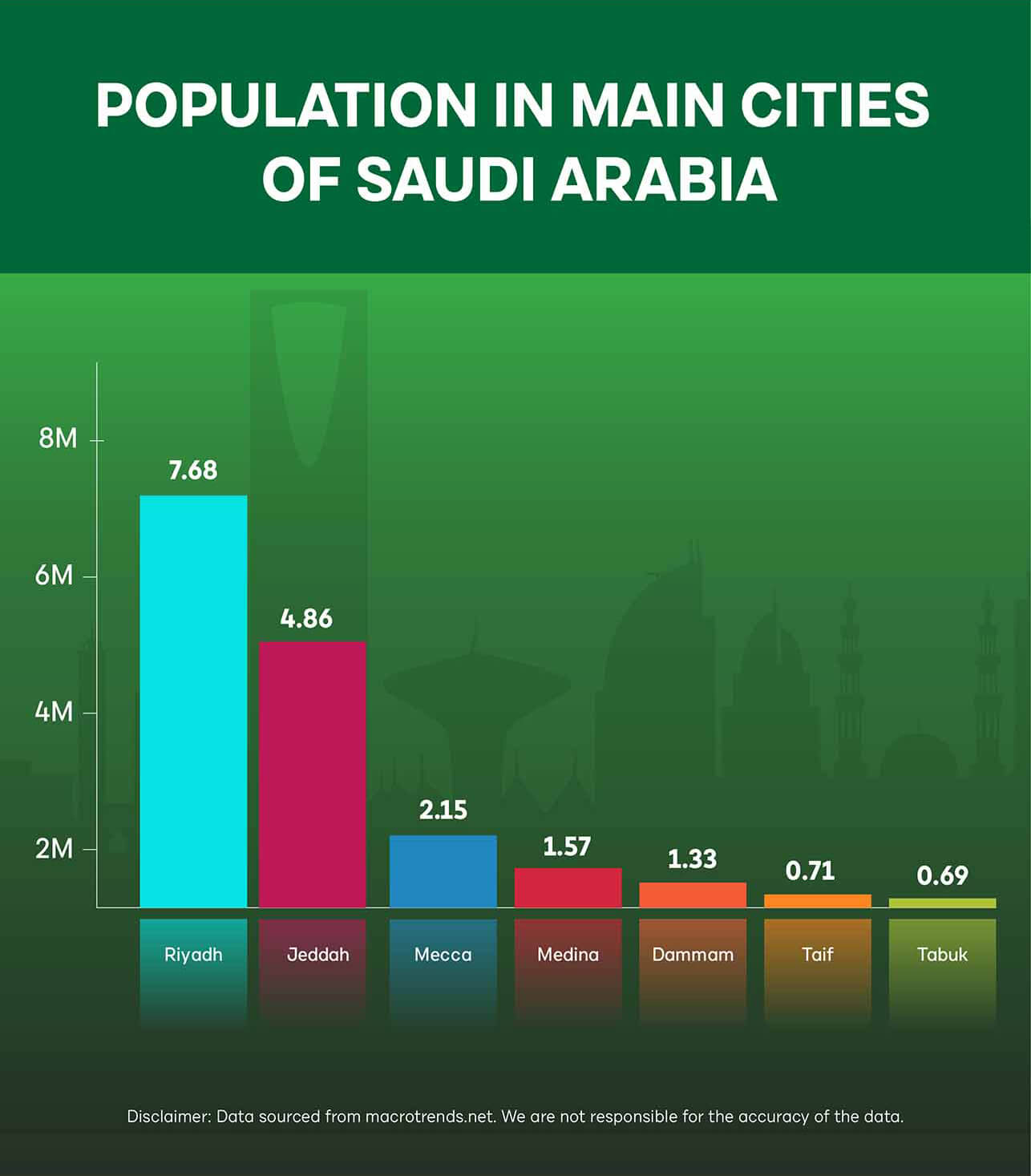
With rapid urbanization, 84.7% of people have settled in major cities and around 15% people are still living in rural areas. There are 26 main cities in KSA and we will be looking at the ones that have the highest population.
The capital city, Riyadh, which reflects some major economic growth, hosts the highest population of 7.68 million people. It is followed by Jeddah, a modern port city and Mecca’s gateway, which has a population of 4.86 million people. The two holiest cities in Islam, Mecca and Medina, have populations of 2.15 million and 1.57 million, respectively. Another main city of the country is Dammam, which grew rapidly after the 1950s until 2000 to become the 10th fastest-growing city in the world. It has a population of 1.33 million. Taif and Tabuk are the other two other major cities in KSA; they are home to 0.71 million and 0.69 million people, respectively.
|
City |
Population |
|
Riyadh | 7.68 Million |
|
Jeddah | 4.86 Million |
|
Mecca | 2.15 Million |
|
Medina | 1.57 Million |
|
Dammam | 1.33 Million |
|
Taif | 0.71 Million |
|
Tabuk | 0.69 Million |
Saudi Arabia Birth Rate, Death Rate & Migration Rate 2023
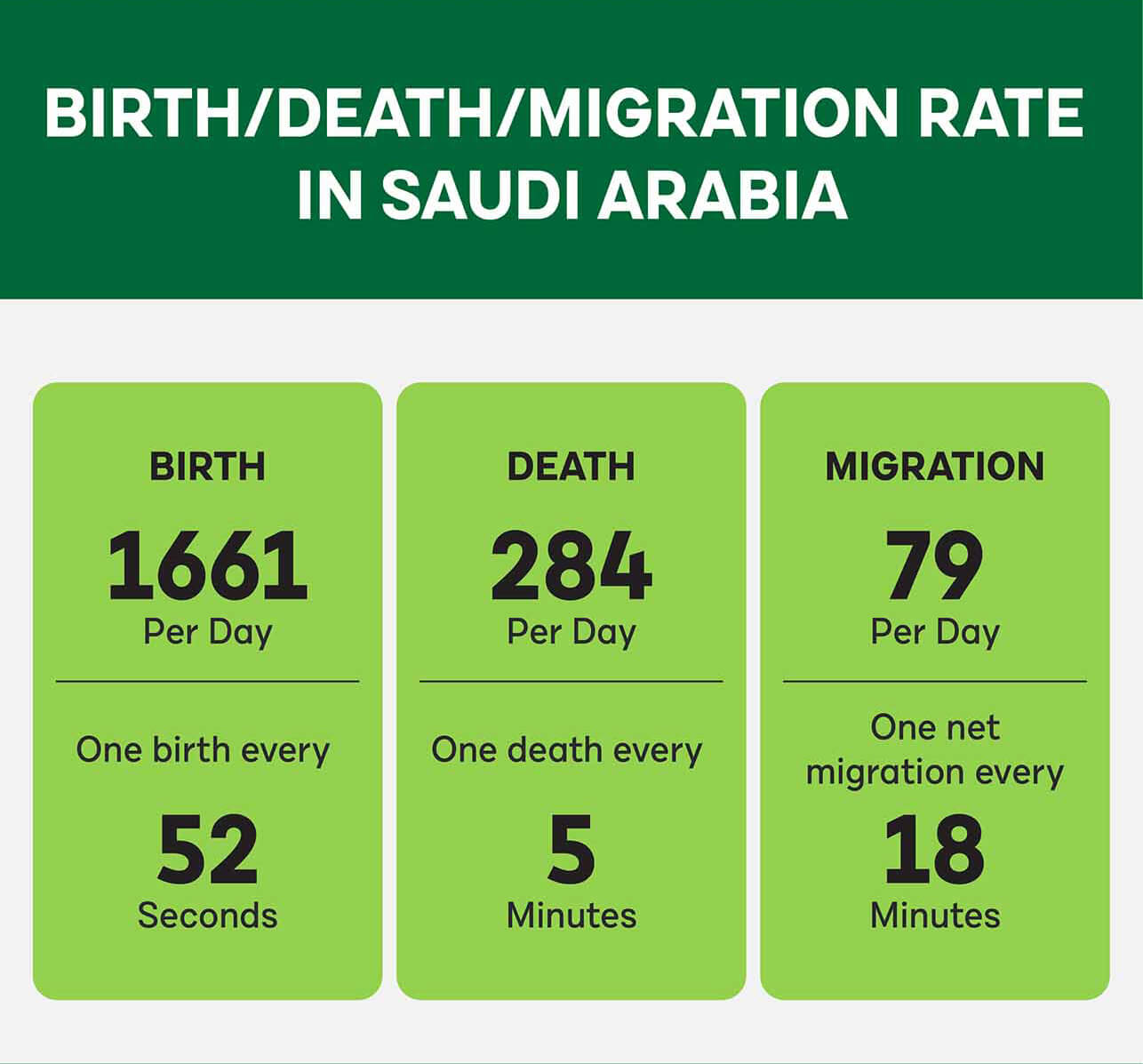
A country’s socioeconomic and medical achievements are determined by its birth, death and migration figures. According to reports, there are 1661 births and 284 deaths every day in Saudi Arabia as of January 2023. That means one person dies every 5 minutes and one child is born every 52 seconds. The country is defined as one of the highest developed economies in the world by the UN. The reflection of this can be seen in its improving birth rate and decreasing death rate across the country.
KSA is heavily reliant on foreign labour, and many Saudis are migrating to other countries also. At the moment, 79 migrations occur per day, with one new immigrant arriving in KSA every 18 minutes. In 2023, as the country undergoes reforms with its new and improved labour and migration policies, it will be interesting to see how the measures work in terms of immigration trends in the country in the years to come.
Saudi Arabia Population by Religion 2023
93% of the population of Saudi Arabia practises Sunni Islam, making it a predominantly Islamic nation. Yet it also embraces a variety of different faiths and demonstrates a high level of religious tolerance and harmonious cohabitation. Christianity is practised by 1.60 million people, i.e. 4.4% of the population, while Hinduism is practised by 0.40 million people (1.1% of the population). 0.7% of the population or 0.25 million people, do not identify with any religion. 0.3% or 0.11 million people practise folk or traditional beliefs and an equal percentage are Buddhists. 0.2% or 0.07 million people follow a number of other religions.
Religion | Percentage | Population (in Million) |
Islam | 93% | 33.79 M |
Christianity | 4.4% | 1.60 M |
Hinduism | 1.1% | 0.40 M |
Religiously Unaffiliated | 0.7% | 0.25 M |
Folk or traditional religions | 0.3% | 0.11 M |
Buddhism | 0.3% | 0.11 M |
Others | 0.2% | 0.07 M |
Saudi Population Forecasts/Predictions
Based on births, deaths, and migrations, the KSA’s population increases by one person every 59 seconds. And according to some sources, the population of the country is expected to reach 39.93 million by 2027.
Saudi Arabia is in its early stages of social and economic development. Many societal changes including issuing driving rights to women and opening the borders to tourists other than Haj pilgrims show that the country is expanding its horizons. This can bring about a change in the country’s demographics and the overall population in the coming years.
Disclaimer: GMI acknowledges that though we try to report accurately, we cannot verify the absolute facts of everything that has been presented in this blog. The information presented is based on information researched from various sources on the internet. We are not liable for any errors, financial loss, or damages of any kind that may result from the use of, or reliance on, the information herein.
(You can continue reading about the population statistics of Saudi Arabia 2022 below.)
Saudi Arabia Population 2022 (Key Statistics)
- Saudi Arabia’s population in 2022 was 35.84 million.
- The population density of Saudi Arabia is 16.67 people per square kilometre.
- The median age is approximately 32.4 years
- In Saudi Arabia, the male population is 20.70 million and the female population is 15.14 million.
- With 7.54 million people, Riyadh is the most populous city in Saudi Arabia.
- In 2022, the urban population in Saudi Arabia is 30.36 million.
Saudi Population Statistics 2022 – Infographics
Demographics of Saudi Arabia in 2022
Let us analyze the demographic data of Saudi Arabia in 2022 based on different categories:
Gender Split
The gender split of a population is indicative of the disparity between different genders in the society. In Saudi Arabia, the male population is 20.70 million i.e. 57.76% of the population while the female population is 15.14 million i.e. 42.24% of the population. This skewed sex ratio is prevalent in the countries in the Arabian Peninsula like Qatar, UAE and Saudi Arabia.
Saudi Population by Age
|
Age Group |
Population |
Population (Percentage) |
|
0-14 years |
8.72 Million |
24.34% |
|
15-24 years |
4.69 Million |
13.10% |
|
25-54 years |
18.59 Million |
51.86% |
|
55-64 years |
2.47 Million |
6.89% |
|
65 years and above |
1.36 Million |
3.81% |
The age-wise population of KSA shows that the highest percentage of people belong to the age group of 25-54 years. This group consists of working expatriates and locals. There are 18.59 million i.e. 51.86% people in this age group. The lowest percentage of people belong to the age of 65 years and above. The elderly population of Saudi Arabia is 3.81% or 1.36 million people.
Saudi Population by Gender
|
Age Group |
Men |
Women |
|
0-14 years |
4.43 Million |
4.29 Million |
|
15-24 years |
2.46 Million |
2.23 Million |
|
25-54 years |
11.39 Million |
7.20 Million |
|
55-64 years |
1.67 Million |
0.80 Million |
|
65 years and over |
0.75 Million |
0.62 Million |
The gender disparity is spread equally across all sections of the population here. Males dominate all the age categories. The male population is highest among the 25-54 years age group i.e. 11.39 million and lowest among 65 years and over i.e. 0.75 million. Similarly, the female population is also highest among the 25-54 years age group i.e. 7.20 million and lowest among 65 years and over i.e. 0.62 million.
Saudi Arabia Birth Rate, Death Rate & Migration Rate 2022
The birth rate per day in Saudi Arabia is 1568 persons every 55 seconds and the death rate per day is 354 persons every 4 minutes.
The KSA is the ‘future city’ that is attracting a huge number of migrant workers. Along with the numerous work opportunities, workers also enjoy tax-free salaries and a low cost of living here. Saudi Arabia is a digital hub in the making. Around 193 migrant workers land in the country every 7 minutes.
Saudi Arabian Labor Force 2022
The labor force of a country is its backbone and in Saudi Arabia males have dominated this sector for decades. The total labor force this year stands at 15.9 million people. Out of this females occupy 20%. Although this may seem small, compared to earlier days there is a significant increase in women’s participation today. In 2017 only 14.8% of the labor force consisted of females. Since then there has been a steady increase in the number of females. The reformative steps taken by the government have contributed to this positive change. (World Bank data)
Population in Main Cities of Saudi Arabia in 2022
|
City |
Population |
|
Riyadh |
7.54 Million |
|
Jeddah |
4.78 Million |
|
Mecca |
2.12 Million |
|
Medina |
1.55 Million |
|
Dammam |
1.31 Million |
|
Taif |
0.70 Million |
|
Tabuk |
0.68 Million |
Saudi Arabia ranks 13th in the world for its area size and therefore is home to a large population. Riyadh, the administrative, political and cultural capital of KSA, has the largest population among all the cities in Saudi Arabia. 7.54 million people are living here. Jeddah, also known as the modern port city, is home to 4.78 million people. Mecca and Medina are the religious cities of the KSA. While Mecca has a population of 2.12 million, Medina has a population of 1.55 million. Dammam, a popular tourist destination, has a population of 1.31 million. Taif is known for its pleasant weather in the summer months and therefore is the summer getaway city. It has a population of 0.70 million people. Tabuk boasts a rich historical heritage. It has a population of 0.68 million people. Apart from these, there are other cities too that are spread across the 13 regions of Saudi Arabia.
Saudi Arabia Population 2022 (Urban v/s Rural)
Saudi Arabia has been slowly and steadily moving towards urbanization. In 1960 the urban population rate was 31%, which grew to 79% in 2000. In 2022, the urban population accounts for 84.7% or 30.36 million. Most of the urban settlers choose to live in the major cities of Saudi Arabia like Riyadh, Dammam, Mecca and Jeddah. Comparatively the rural population only amounts to 15.3% or 5.48 million people.
Social Media Users in Saudi Arabia 2022
|
Social Media Platforms |
Users |
Users (Percentage) |
|
YouTube |
29.30 Million |
81.75% |
|
|
15.45 Million |
43.11% |
|
|
11.40 Million |
31.81% |
Multiple social media platforms are prevalent among the Saudi Arabians. It is replacing the traditional mediums of news and information and also influencing positive changes in society. Among all the social media platforms, YouTube has the highest number of users with 29.3 million people using it i.e. around 81.75% of the population. This is followed by Instagram which has about 15.45 million users i.e. 43.11% of the total population. Facebook users account for 31.81% of the population i.e. 11.40 million people.
To get your brands message to your clients in Saudi Arabia or abroad get in touch with Global Media Insight today. We have over 23 years of experience in digital technologies and social media and digital markets along with expertise on the latest tools to drive engagement to increase your business brand value and customer loyalty. Talk to us to discover social media strategies that work across platforms and channels.
Disclaimer: GMI acknowledges that though we try to report accurately, we cannot verify the absolute facts of everything that has been represented on this infographic. The information represented is based on information researched from various sources on the internet. We are not liable for any errors, financial loss, or damages of any kind that may result from the use of, or reliance on, the information herein.

GMI’s Research Team is a panel of knowledgeable experts from various fields such as digital marketing, social media, and web development, all united by a common goal—to educate. We enjoy exploring everything from the latest industry trends and emerging technologies to people and demographics, both in the UAE and beyond. Through our blog posts, we share valuable insights that help businesses and marketers stay informed and prepared for the challenges and opportunities that lie ahead.


